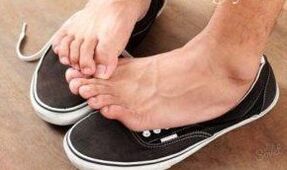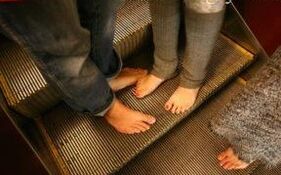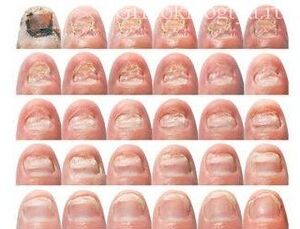The nail fungus is a rather dangerous phenomenon that can progress, destroying the entire nail plate. In the early stages of development, the mushroom can be invisible to the eye, however, its negative effect on the structure of the nail plate is intensified every day. How to identify yourself the nail fungus and how to treat it, given the stage of the disease, we will analyze further.

There are numerous signs that help to determine the presence of fungal lesions of the nail plate:
- The training of the nail: you can check when cutting the edge of the nail. If the nails crumble in the process, not cut, this is the first symptom of the presence of a mushroom and a clear opportunity to see a doctor.
- The thickening of the nail plate, mainly on the hyperkeratosis of the edge (compaction) occurs due to the harmful effects of the mushrooms that can interrupt the integrity of the nail fibers, which is why the latter change in qualitative and quantitative form.
- Epplalation of the nail and its cut under the skin: such a phenomenon can cause not only to wear narrow shoes, but also fungal lesions that modify the nail plate, providing the wrong position.
- The change in the color of the nail (from pale yellow to brown) - occurs due to the destruction of the active components of the nail plate and the folding of protein cells during destruction.
- The presence of white plaques - fungal spores deep in the root of the nail and also on the surface, which is dangerous for the wide infection of all the fingers of the feet.
The first signs that the nail has lost health and has problems caused by the active activity of the mushrooms, are:
- loss of shine and luster of surface;
- Light yellowing of the nail;
- Extended itching of the entire foot, the appearance of red points full of transparent liquid;
- Unpleasant smell of the legs, especially after abundant sweating;
- Crossing the skin on heels and soles, a wide enlargement.
These symptoms indicate various problems with legs, so it is better not to neglect the consultation of a doctor. Early diagnosis significantly facilitates the processing process, ensuring complete recovery.

Healthy legs on the legs: norm and deviation
To exclude or identify the presence of fungal diseases, it is necessary to examine your legs, fingers and nails. The following indicators must be maintained:
- The foot of the legs is smooth, without seeds, corn and seals.
- The skin of the legs is uniform, without cracks and spots.
- There is no redness and itching, especially between the fingers.
- The nail plate is flat, simple, transparent.
- The nail bed, the surface with shine is clearly visible.
If there are deviations from the declared standards and the legs have an unpleasant pungent smell, a doctor's consultation and a survey for the presence of the pathogen are required.
Risk factors for the development of mushrooms on the legs
The mushroom infection can occur in any place absolutely, including home slippers. So that this happens enough to have:
- weak immunity that is unable to retain the active reproduction of mushrooms;
- increase in the sweating of the legs, due to selected improper shoes and poor quality;
- the presence of cuts in the nail area with a successful cut of the nail or cuticle;
- Insufficient foot hygiene and shoes;
- Frequent visit to public places where there is a high risk of infection: city bathrooms, saunas, solarium, swimming pool, local beach;
- Excessive use of cosmetics (paints, nail extension, refreshing sprays and legs of legs), which lead to the death of local immunity.
The separate types of mushrooms have a different latent period during which the disease does not manifest itself.
You can be infected with a mushroom in two ways:
- Contact - Through direct contact from a sick person to a health: personal hygiene objects, public places, wearing someone else's shoes.
- Contacted: the infection occurs due to the active development of those mushrooms found in each person's body. In some situations (for example, a strong decrease in immunity), their number increases and cannot be completely controlled by the body independently.
Very often, the people of the following categories are subject to fungal injuries:
- children with a thinner layer of skin;
- people suffering from HIV infection;
- with an increase in the sweating of the feet;
- The presence of chronic diseases that inhibit the immune system.

If there are the above indicators, the condition of the nails on the legs and the stop as a whole must be carefully monitored, paying due attention to hygiene.
Differentiation of a fungal nail disease
In medicine, the concept of "fungal damage to the nail" is collective, since the mushrooms of various kinds can act as pathogen. Very often, these mushrooms are on the nails of the legs such as:
- Dermatofiti - A group of mushrooms that manifest themselves in the form of yellow spots or white vertical stripes. The infected nail gradually loses its strength and shape, after which the cavity becomes lifeless and easily removes from the nail bed.
- Yeast lesions - arise following the active activity of mushrooms of the candid genre. The nail itself is thinner and the peroline roller blushes and swells. It can manifest itself as an independent disease with frequent and weakened colds.
- Molds: they are mainly found on the surface of the nail, changing its color in a greenish, brunastra or whitish tint.
It is impossible to determine by the causal agent of a fungal disease, since the fungi themselves, if exposed to various aggregate factors, can manifest themselves differently. Consequently, it is impossible to start treatment, since each type of mushrooms has its antifungal drugs that negatively influence the life of pathogens. Therefore, when they diagnose the minimum deviations from the standard, you need to consult a doctor and take a test for the presence of a mushroom.
Fungine damage phase in the legs
The process from the moment of infection to the complete destruction of the nail plate is called the stadium of the course of the disease. Selecting 5:
- Infection: the mushroom enters the surface of the nail, immersing itself through the cuticle in the nail bed.
- The incubation period (from 3 days to 5 months) - The activity of the mushrooms is minimal, but intensifies with the speed of light when all the conditions are created for this: immunity is weakened, there is a hot half wet, there is no adequate hygiene. Externally, the incubation period does not manifest itself in any way.
- The initial phase: the number of mushrooms is so large that it can have a negative effect on the vitality of the nail. The edges of the nail plate gradually rotate the yellow from the edge to the nail bed. The nail acquires an opaque shade, a healthy pink color disappears, the shine disappears from the surface. In this case, the dry skin of the fingers of the feet is noted.
- The stage of the active route: the population of mushrooms reaches its maximum, which allows you to infect other nails plates, having received disputes through contact. Hypercheratosis has improved: increase in the production of keratin fibers, under the influence of fungal activity. In this case, the nail is compact, considerably protruding over the surface of the finger.
- The last stadium - is determined by the murder of the nail plate due to the injury not only of the nail, but also of the close soft fabrics. The entire surface of the nail has a yellow or brown shadow, the cutting on the cut is noted, which is accompanied by painful sensations.
With large scale infection, local symptoms can also join:
- dysbiosis in the form of stool disorder;
- increase in body temperature;
- leg pain, intensifying during movement;
- Connection connection.
All the above events help to determine exclusively the stage of the course of the Onychomicosis. To identify the pathogen, you will have to make a special analysis that indicates the exact genre and the type of mushrooms that caused the onychomicosis.
How and what to treat

You must understand that the key to successful treatment is a correct diagnosis, which is impossible to do at home. Only a doctor, based on the results of the analyzes, is able to identify a kind of mushrooms, as well as choosing the appropriate treatment.
For many, it remains a mystery because, the antifungal drug purchased in the pharmacy does not help. There are many reasons and explanations for this. Firstly, initially the anti -fungary drug is selected according to the generator. Secondly, the mushroom treatment is a complex event composed of:
- Local therapy - Application of antifungal drugs on the surface of the nail.
- Oral anti -power tablets that can suppress the development of mushrooms and reduce their number from the inside.
- Immunostimulating drugs that "force" the body to produce a sufficient number of immune trolleys that independently fight mushrooms.
- Respect for the hygiene of the feet: the legs are washed 2-3 times a day, with fresh water and soap, after which they dry with a towel. The nail is cut every 3-5 days.
- Wearing real leather and cotton linen shoes.
Having excluded at least one of these 5 points, the recovery process will drag for many months or even will not be successful. Only a complete treatment will allow you to completely get rid of the mushroom, as well as excluding the risks of the manifestation of the relapse.
The recipes for traditional medicine, which are so difficult to take care of the nail fungus are in most cases ineffective. The result will appear only when the above for the struggle will be added the fungal injuries of the nails.
Therefore, it is not difficult to determine the presence of a mushroom on the nails of the legs. It is sufficient to conduct an inspection of the nail plate and all fingers in general, comparing them with the images that indicate the presence of a mushroom. The treatment is considered effective and correct only when it is carried out under the control of specialists. The car -mediation can cause many negative consequences for health, as well as complicating a further treatment of the disease.
















